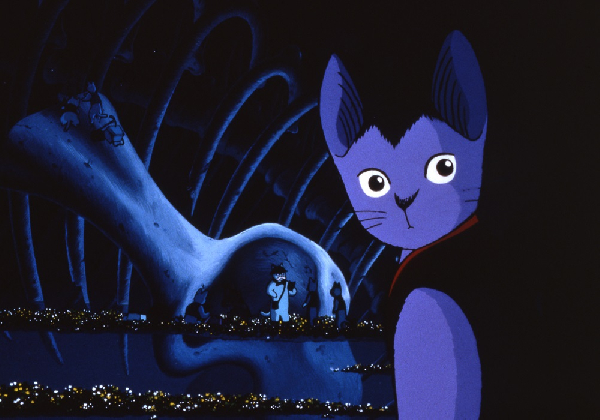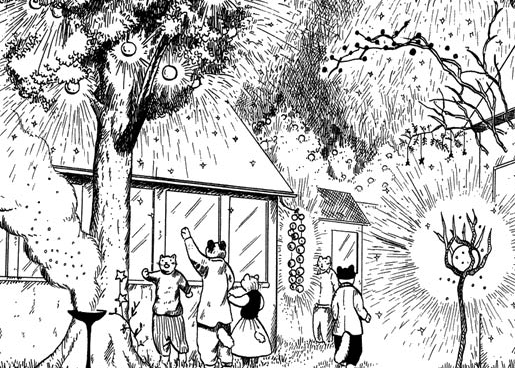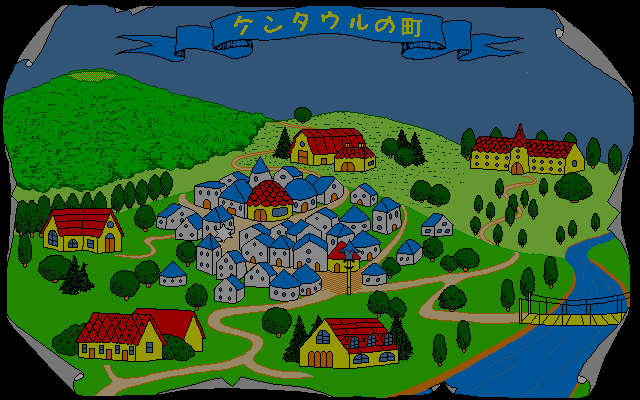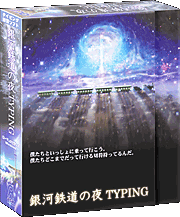Night on the Galactic Railroad
End of Page Ctrl + ENDThis is the main page for "Night on the Galactic Railroad" / 「銀河鉄道の夜」
 The title's translation can vary as Milky Way Railroad, Night Train to the Stars or Fantasy Railroad in the Stars, or more too. There will not be much depth in description here, but I'll provide links with those too.
The title's translation can vary as Milky Way Railroad, Night Train to the Stars or Fantasy Railroad in the Stars, or more too. There will not be much depth in description here, but I'll provide links with those too.
It's a widely known nine-chapter fantasy novel from Kenji Miyazawa. The original four versions were written in 1927 and published first in 1934 after Miyazawa's death.
It is best experienced through one of the many translations, drafts of the novel, or various other adaptations.. I hope to give a good guide on these available and any information related. Let's take a trip on the Galactic Express.
Outside Links Differences Adaptations Allusions
Over the course of 9 chapters, Giovanni and Campanella take an adventure over the Galactic Railway. Meeting various people and hearing all sorts of stories, in the pursuit of 'true' happiness, purpose and beauty, it's both fanciful and sincerely melancholy. Often taking religious views from both Christianity & the Lotus Sutra. Even as a epistolary novel it created a vivid world for many.
Outside Links
- The World of Kenji Miyazawa [EN]
- Wikipedia Summary [EN] / [JP, Much more Info]
- [JP] 賢治の見た夢〜銀河鉄道の夜〜
- [JP] gingatetudounoyoru.com
Differences
Between Drafts
The first draft was written roughly around 1924, most of the differences in the first to third drafts in comparison to the fourth and 'final' remain in the beginning & ending. The drafts 1-3 before the 'final edition' beginning at Chapter 4 (Night of the Centaurus Festival), and having a vastly different ending from Chapter 9 (Giovanni's Ticket).
The final draft's prologue adds the afternoon class explanations, more focus on time spent with Giovanni's mother and further hope or ambiguity on his father's situation. This is not found within the first drafts as it starts only during the night portions of the story.
Dr. Burcanillo is a character that only appears throughout the story of the older versions prior to the fourth draft. During the 6th Chapter he's alluded to calling Giovanni into boarding the Galaxy Express, and they hold an indirect conversation. Then he returns towards the end, Chapter 9, with a similar description. After Campanella's exit, Dr. Burcanillo explains his journey to Giovanni, and implores him to seek the greatest happiness for all people.
*Strange ads and images
Outside Links Differences Adaptations Allusions
Adaptations
Movies / Planetarium Program
My page for details on the 1985 animated film of the same name can be found here.

In 2006 KAGAYA, illustrator for the astronomy magazine 'Hoshi Navi', released 'The Celestial Railroad', a reading of the story accompanied by music and fully animated CG environments. Released in Japanese, Chinese and English. It doesn't entirely adapt the story, instead encouraging the viewer to read the story on their own. Multiple versions/releases exist and it is most often shown as a planetarium program ! Archive of the promotional site [ENG + JP] and gingatetsudounoyoru's English information on the show.

Also from 2006, 「銀河鉄道の夜 I carry a ticket of eternity」 is a live-action adaptation making major changes to the setting & characters. Promotional Website.

Manga
My page for details on the 1983 manga of the same name by Hiroshi Masumura is here.

There are more loosely related manga by various artists too, not exact adaptations, but more than inspired even if fundementally or tonally different.
- Shinji Imura's Night on the Galactic Railroad (銀河鉄道の夜), 1988. It's rather short.
- Ikki Matsuda's manga of the same name, 1992.
- Shinji Nagashima's adaptation, 1996.
- Shu Katayama's adaptation, 1996.
- Variety Art Works' adaptation, 2007.
- Ayano Kitahara's adaptation, 2010.






Games
In 1994 トンキンハウス (TONKINHOUSE) released 銀河鉄道の旅 on the PC-98, advertised as a 'Digital Novel' adaptation of the story. It uses elements from both the first three drafts as well as the fourth or final. There is not much information available, though it is playable and I have reuploaded gameplay too. Details here.

銀河鉄道の夜TYPING also from KAGAYA and 桑島法子, playable on Windows XP, Me, 2000 and 98, full official information and promotional material here.

Music
Nokto De La Galaksia Fervojo / 銀河鉄道の夜, a CD from Joe Hisaishi released on July 20th, 1996, commemorating 100 years since Kenji Miyazawa's birthdate.
Theatrical Plays & Musicals
The shadow puppet play 「藤城清治 銀河鉄道の夜」 / (Seiji Fujishiro: Night on the Galaxy Express) premièred in 1956, later visualized & released on DVD in 2007.
Tokyo Engeki Ensemble's 「銀河鉄道の夜」 theatre performance of February 9-22 1982, performed again each Christmas.
(Sōkō: Night on the Galactic Railroad) 「想稿・銀河鉄道の夜」 written by Sō Kitamura, shown in 1986.
'Ikhatovo's Musical Drama' / イーハトーボの音楽劇「銀河鉄道の夜」 first performed in 1995.
The 2001 musical Ihatov Dream / バウ音楽詩劇 『イーハトーヴ 夢』「銀河鉄道の夜」.
光速銀河鉄道の夜(賢治島探検記内) Theatre performance of 2002, presented as an adaptation of the final draft while also including elements of others such as Dr. Burcanillo.
A musical of the same name as the story, ran between 2004-2007, script written by Shin'ichi Ichikawa, with the will of making something as close to the original story as possible.
Musical drama 「群読音楽劇 銀河鉄道の夜」 shown each summer since 2007.
Himawari Theatre Group's 2008 musical.
「人形演劇 銀河鉄道の夜」 2010, a puppet show.
「星めぐりのうた」 Musical first shown in 2012.

Outside Links Differences Adaptations Allusions
| Works influenced by or referencing the story: |
| Galaxy Express 999 |
| Ihatovo Monogatari, a game dedicated to Miyazawa's works includes the Galactic Railroad as a key element. |
| Subarashiki Hibi's first chapter is an extended homage to it, made especially clear at the end. |
| Albireo of .hack//AI buster expresses how his screen-name was chosen due to the description of the star within the story, and the various drafts are referenced to again at a later point. |
| Within 半分の月がのぼる空 (looking up at the half-moon) it's Rika's favourite book from her father, it's referenced often as she teaches it to Yuichi, and they call eachother Campanella & Giovanni. |
| In YU-NO the Galaxy Express is briefly mentioned. |
| The song 銀河鉄道の夜 from GOING STEADY. |
| The novel appears and is thoroughly referenced in Doraemon along with Galaxy Express 999. |
| KASHIWA Daisuke's song "stella" (program music) was made out of will to "Express the story using sound". |
| Planetarian uses many of Kenji Miyazawa's compositions and shares motifs with the story. |
| Aria makes heavy reference to the Galactic Railroad and Hiroshi Masumura's adaptations. |
| Albireo from Pop'n Music, both his name, likes, design, birthdate and birthplace (Ihatov) are an allusion to the story. |
| Monica Campanella is a light allusion to Campanella in both name and her fate. |
| In Pokémon Gold, Silver & Crystal the television in the player's house says "There's a movie on TV: Stars dot the sky as two boys ride on a train...". |
| 「こどものための交響詩-銀河鉄道の夜」included in 『世界子供百科』(1972) is dedicated to the story. |
| The protagonist of A Bride for Rip Van Winkle uses Campanella as her screen name, and claims Night on the Galactic Railroad as her favourite. |
| Ultra Q's Episode 28 feature's a train with heavy parallels to the Galaxy Express. |
| Azusa 999 (1997) is dedicated to it & Galaxy Express 999. |
| 「ピアノ協奏曲第一番”蠍火”:Virkato」of Beatmania IIDX 11 IIDXRED is a partly unintentional reference to the scorpion. |
| "For Campanella" (sung by GUMI) is based on the story. |
| Kyorochan Episode 33, (銀河特急でGO!) is an extended reference. |
| 「銀河鉄道の夜」 by ZABADAK. |
| Bernkastel and Lambdadelta reference the story and Galaxy Express 999 in Umineko. |
| Mawaru-Penguindrum repeatedly references it & the 1985 movie. |
| Giovanni's Island holds a deep connection to the story. |
| The characters of Act-Age perform a theatre play of the story. |
| A brief mention in Buddyfight Ace Episode 8. |
| A mention of the story & Albireo in reference to Amanogawa Saya in the visual novel A Sky Full of Stars. |
| The manga Yakitate!! Japan references the story, while the anime references Galaxy Express 999. |
| Namings |
| A Train Line within the same region Kenji Miyazawa grew up in, Iwate Galaxy Railway Line (いわて銀河鉄道線) |
| Tanohata Station's nickname of 'Campanella'. |
| 'Galaxy Dreamline Kamaishi Line' (銀河ドリームライン釜石線) & a manhole's engraving near it. |
| 「銀河鉄道展望公園」 Observation park. |
| The poetry publisher, Coalsack Publishing (コールサック社) |